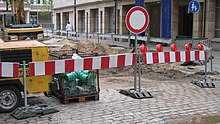Lane closure
A lane closure is a traffic law measure and describes the partial or complete closure of a public traffic area for all traffic. The road user is made aware of the lane closure (possible versions: full or partial closure) by means of appropriate signs . Road closures may be necessary due to a traffic accident , an event or because of a job .

Partial closure
A partial blockage occurs when starting several lanes of traffic just over a hard shoulder (Austria and Switzerland emergency lane (o accident, construction site. Ä.)) Or the opposite lane at the dam site can be directed past. Here, the traffic route narrows from several lanes to a single (emergency) lane with suitable traffic control by emergency services in the event of an accident. A partial block is usually limited in time.
The partial closure is not to be confused with a narrowing of the lane . There is at least one (temporary) lane left in each direction of travel.
full closure
A full closure - also total closure - occurs when a public traffic area is completely closed to traffic (including local traffic ). It is only ordered by the road traffic authority in exceptional cases, as it interferes significantly with the usual traffic flow. If it is a long-term planned full closure, for example for a road construction project, a diversion route will be set up, which is announced with the help of the media and corresponding signage. In the event of a short-term full closure, for example due to an unsecured accident or danger zone, every road user can block for self-protection, after which emergency services (such as the police ) usually take over the control and management of the traffic. Particularly on motorways and expressways, traffic jams then form, which can be reduced with the help of a diversion and the use of diversions .
Notes for truck drivers
According to the consultation with the Federal Office for Goods Transport (BAG), full closures are considered a compulsory break, so users of the digital tachograph can press the "break" button, but must remain seated in the vehicle! If the traffic authority decides in favor of a diversion, the responsible regional council can temporarily lift the truck traffic ban and have this reported on the traffic radio if the possibility (lane width, height or weight restriction) allows this. On weekends and public holidays , the BAG is entitled to make decisions in the interests of the regional council.
An ordered and announced derivation ends the "break" on the digitachometer, but this does not apply to the transport of dangerous goods and heavy transports . The latter must remain on the route until the end of the full closure.
A wide diversion recommendation for the following traffic (before the lane is closed) must be announced on the traffic radio in good time, and if necessary a diversion must be initiated.
Legal basis
The state police of the federal state concerned, and the rescue control center as a makeshift decision, decide whether a traffic route can remain passable or not.
Norms and standards
- Germany
- Guidelines for Securing Workplaces on Roads (RSA 95)
- Additional technical contractual conditions for safety work at workplaces on roads (ZTV-SA 97)
- Austria
- RVS 05.05.40 - Construction site protection
- Switzerland
- SN 641 505a - Construction sites on roads with traffic
- SN 640 885c - Signalization of construction sites on motorways and motorways
- SN 640 886 - Temporary signage on main and secondary roads

